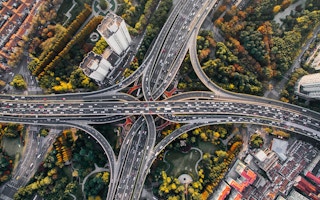The last leg of your express delivery in China normally comes through on the back of rinky-dink electric tricycle scootered through the neighbourhood to drop off packages to their final destination, so among the public the industry generally has a reputation for being environmentally friendly.
To continue reading, subscribe to Eco‑Business.
There's something for everyone. We offer a range of subscription plans.
- Access our stories and receive our Insights Weekly newsletter with the free EB Member plan.
- Unlock unlimited access to our content and archive with EB Circle.
- Publish your content with EB Premium.
This pastoral scene, however, is only the final, most visible end of a high emissions industry that is on track to produce even more greenhouse gases.
Overall, carbon emissions from China’s transportation sector declined between 2018 and 2020. But a recent report from Greenpeace shows that this figure is actually increasing by 30 per cent per year.
Mainline transport accounts for 94 per cent of total emissions in the delivery sector, where the electric tricycle-driven last mile of inner city transport is just a fraction. But most decarbonising efforts so far focus on packaging or warehousing.
Trains are the most emissions efficient way to transport goods with the least carbon emissions. But unfortunately, trains are the last choice for express delivery firms in China. In 2022, only 4.8 billion packages were shipped by train, which constitutes 0.05 per cent of the total annual package volume. Airplanes carry about twice the amount of packages as trains, but emit about 33 times the amount of carbon. Meanwhile, trucking lands somewhere in between in terms of efficiency, but the majority of total emissions come in this sector come from trucking.
Trucking is what some call the “middle ground” of decarbonisation efforts. Electrification is the easiest way for transport to avoid fossil fuels and reduce emissions (where the electricity comes from is another question), but so far this technology has been used mainly in smaller vehicles with shorter distances and lighter loads. For heavy ground transportation, the availability of alternative energy sources at that battery capacity remains extremely low. There remain some technical obstacles, and many advanced technologies are expensive and difficult to apply at scale.
On the other hand, aviation also produces a lot of emissions in the logistics industry, only second to road transport, accounting for 42 per cent of the total emissions of mainline transport. Since airplanes are seen as symbols of wealth, quality and speed, all express delivery companies that own airplanes display them in a prominent position on the home page of their websites. More and more firms are now buying their own planes and using them as attractive gimmicks in an effort to appeal to their customers. According to Boeing’s prediction, more than 700 cargo planes will be delivered to Chinese companies over the next two decades, a sizable portion of which will be for air operations created by express delivery companies.
The cost of producing sustainable aviation fuel by different technological paths is two to six times higher than the price of today’s jet fuel. According to International Air Transport Association (IATA), the aviation industry won’t be able to completely eliminate emissions at source, which means the aviation industry’s decarbonisation process will be more complicated.
Even though decarbonising heavy transport and aviation are serious challenges globally, enterprises still have many opportunities to improve their services in terms of climate change. Recently, a few logistics firms published its own decarbonising goals in China. This allows them to think about their services again and find more meaningful points to reduce their emissions.
For example, re-arranging delivery routes, replacing fuel trucks with more new energy trucks, choosing trains more, and guiding customers to change their delivery expectations and habits. First, the enterprise needs to realise its role on the climate front, and designing its decarbonising goals can be a good start.
Worth noting that, when logistics firms use electric vehicles in the delivery within cities to show their ambition to lower carbon emissions, their truck drivers and basic services workers bear the brunt of the risk of climate change. Extreme heat and cold pose severe threats to their health, and adverse weather increases the chances of fatal accidents.
In China, the regions where extreme weather happens regularly coincide with ones where express delivery services develop fast and the industry prospers. Logistics firms need to react to climate change, and they should do so as well.
Lu Chen is a reporter focused on climate change and organic farming.









